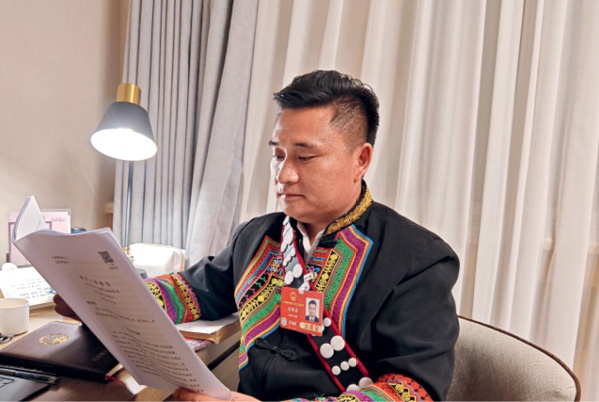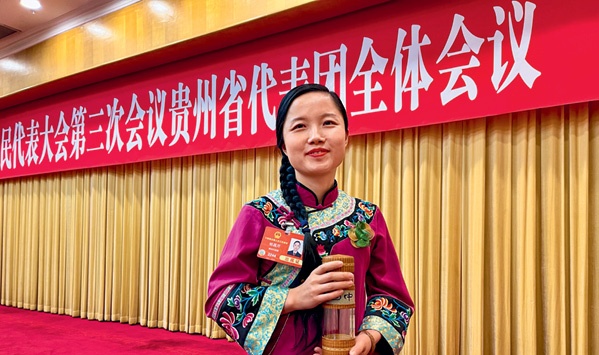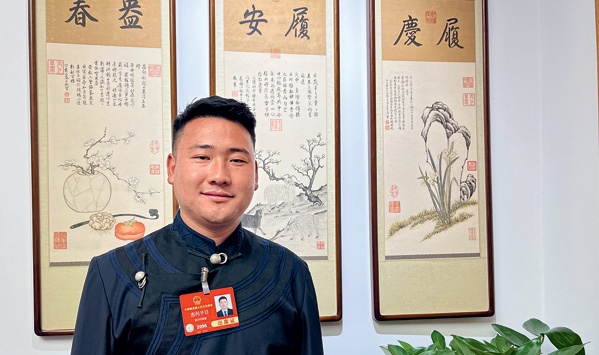
A mountain road in Abuluoha Village in the Jinsha River Grand Canyon in Sichuan Province.
The drive to advance China’s all-around rural revitalization comprises advances in agriculture, revitalization of rural areas, and well-being of rural residents – the “three rural work,” as emphasized by Premier Li Qiang in the 2025 government work report.
Centered on the guiding principle of “raising agricultural returns, invigorating rural development, and increasing rural income,” the report introduced a “three-dimensional code” for rural revitalization. By coordinating policy innovation, industrial upgrading, and institutional reforms, China aims to give strong momentum to the “three rural work.”
This year marks the final year of the 14th Five-Year Plan period (2021–2025) and the last year of the five-year transitional period for effectively connecting poverty alleviation achievements with rural revitalization. How to deepen the comprehensive revitalization of rural areas was a major focus of National People’s Congress (NPC) deputies and Chinese People’s Political Consultative Conference (CPPCC) National Committe members during this year’s “two sessions.”
Food Safety
The report states an inter-provincial mechanism will be launched for major grain-purchasing areas to compensate major grain-producing areas and give greater support to major grain-producing counties to keep them motivated. All localities must shoulder their share of responsibility for ensuring national food security, making concerted efforts to ensure the food supply remains secure.
“This is the first time the government work report has proposed ‘an inter-provincial compensation mechanism’ to balance the interests of major grain-producing and grain-consuming areas through financial transfer payments, ensuring that rural residents and grain-producing areas ‘do not incur losses from engaging in farming and remain motivated to prioritize grain production’,” Zhang Lianqi, a member of the Standing Committee of the 14th CPPCC National Committee, said.
He emphasized that while major grain-producing areas contribute significantly to national grain supplies, they often face economic disadvantages, leading to diminished enthusiasm for farming. In contrast, major grain-consuming areas have more wealth. By inter-provincial compensation, responsibilities for food security can be shared, conducive to fostering a nationally integrated food security system and achieving the vision of China’s food supply remaining firmly in its own hands.
In 2024, China’s grain output reached a historic milestone of 700 million metric tons. Zhang highlighted that the compensation mechanism will ensure progressive gains in grain production, providing robust support for the sustained development of the “three rural work.”
In 2024, China built and upgraded over 5.33 million hectares of high-standard farmland, while coordinating the development of efficient water-saving irrigation systems. These achievements have enhanced its agricultural production capacity and consolidated national food security.

Zheng Wangchun, National People’s Congress deputy from Sichuan Province, says his village will develop rural tourism.
Industrial Upgrading
According to the government work report, integrated advancements will be promoted to develop rural industries, invigorating counties, and raising rural living standards in light of local conditions. Local specialties and industries will be encouraged and development of the non-timber forest-based economy boosted. Rural industries with distinctive features will be supported to extend their industrial chains, increase returns, and recruit and benefit more rural residents, thus expanding the channels for increasing rural incomes.
Jilie Ziri, an NPC deputy, lives in Abuluoha, a village nestled deep in the Jinsha River Grand Canyon in Sichuan Province’s Liangshan Yi Autonomous Prefecture. With mountains on three sides, it is China’s last administrative village to be connected to a highway. Prior to its poverty alleviation in 2020, the villagers subsisted by growing corn and potato and the per capita annual income was less than RMB 2,000. Following the completion of the village road in 2020, the per capita income exceeded RMB 15,000 in 2024.
Jilie Ziri told China Today that developing a non-timber forest-based economy through local farm produce is their current focus. “Navel oranges, wild honey, and free-range chickens are our featured industries. Compared with traditional farming, these ventures have generated returns dozens of times higher. We aim to provide city people with eco-friendly agricultural products,” he said.
Gulu Village in Sichuan’s Ya’an City was once virtually inaccessible. The villagers had to use bamboo ladders to go out of the village or come in. But thanks to government poverty alleviation policies, the village now has mule paths, a paved highway, and an aerial cableway. In March 2024, the village shot to fame online after a viral video showcased its beautiful scenery and sparked nationwide interest among travelers seeking authentic rural experiences.
To enhance tourism, Gulu has upgraded its homestays to eco-lodges with traditional Yi ethnic architecture and modern amenities. It has also developed themed tourism packages, including guided mule path tours, authentic Yi dishes, and bonfires in the evening. These value-added services have transformed the local tourism industry. In 2024, its per capita income reached RMB 18,000.
Zheng Wangchun, NPC deputy and Party secretary of Gulu, said the village did very well in rural tourism over the past two years. “Next, we will focus on strengthening cooperation mechanisms among farmer cooperatives, family farms, and households. By means such as guaranteed dividends, we aim to ensure farmers get proportionate shares of industrial value-added benefits,” he said.
Zhang Lianqi said the No. 1 central document of 2025, the first policy document of the year traditionally focusing on agriculture and rural areas, has also provided directions for deepening rural reforms. During the central rural work conference last year, President Xi Jinping specifically called for further rural reforms and improved support systems to promote rural revitalization.
The government work report says trials will be run to extend rural land contracts by another 30 years upon the expiration of the current contracts.
This will provide rural residents with long-term stable operational expectations, serving as a critical foundation for sustainable development of rural industries with distinctive features. Since the poverty alleviation campaign in 2020, Zheng’s team has led villagers to develop local produce-based industries, such as walnuts, red plums and peppercorns. “If the land contracts are extended for another 30 years, these specialty crops will become a permanent blessing,” Zheng said.

Yang Changqin, National People’s Congress deputy from Guizhou Province, has developed a weaving industry.
A Livable Countryside
Regarding the living environment in rural areas, the government work report promises to improve infrastructure, public services, and the living environment in rural areas to build a beautiful and harmonious countryside for people to live and work in.
“To develop rural tourism, our village has constructed pedestrian walkways, a torch square, and a tourist center in recent years,” Zheng said. Before departing for Beijing for the “two sessions,” he was busy with pipelines for a drinking water project.
In rural areas, tourists experienced delays when attempting to make QR code payments, which could be frustrating. During last year’s “two sessions,” Zheng proposed improving rural Internet connectivity. “It was swiftly approved and within months, every household in our village had broadband access.”
Gulu now has 5G base stations, there are streetlights in front of every home, and its collectively operated homestays are about to open during the Labor Day holiday. “Now tourists can smoothly livestream our village’s scenic beauty and culinary delights, book accommodation through mobile apps, and negotiate agricultural product prices face-to-face with villagers via video calls from the city,” Zheng added.
Jilie Ziri told China Today that while continuing to develop rural industries this year, his village will also improve rural infrastructure and public services. He plans to build a courier station in the village so that locals can receive packages conveniently and send local specialty products out. To drive the common development of surrounding villages, his proposal at this year’s “two sessions” was to build a bridge connecting his village to the Yipan Expressway under construction. This would enable tourists and villagers to access the expressway via National Highway 353, fast tracking local development.

National People’s Congress Deputy Jilie Ziri is working to develop a non-timber forest-based economy.
Common Prosperity
The ultimate goal of rural revitalization is the common prosperity of farmers and rural areas. This is also an essential requirement of Chinese modernization.
Yang Changqin, an NPC deputy from Chishui city, Guizhou Province in southwest China, makes handicrafts using the ancient Chishui bamboo weaving technique. Her creations have developed a local industry which created over 3,000 jobs, boosting farmers’ income. Bamboo weaving plays a pivotal role in linking poverty alleviation and rural revitalization.
Yu Wulin, an NPC deputy from Nujiang Prefecture, Yunnan, is promoting integration of intangible cultural heritage preservation with rural tourism development. There are now over 50 homestays and farmhouses in his hometown, Lao Muding Village, with more than half of the villagers employed in the tourism sector.